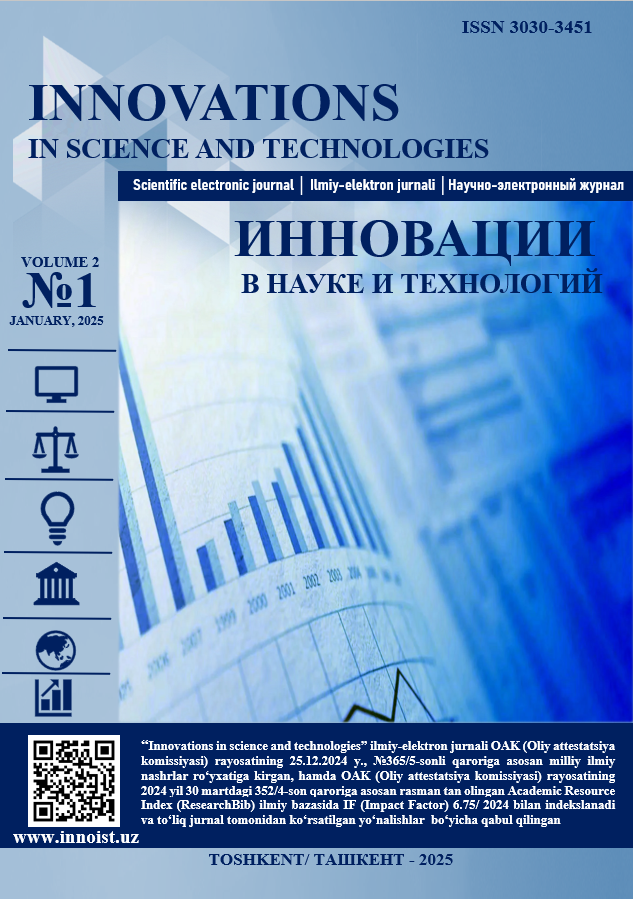EFFICIENCY METHODS OF THE CNN DNN MODEL IN ENHANCING THE QUALITY OF MICROSCOPIC IMAGES AND THEIR VIZUALIZATION
Keywords:
Deep training (Deep Learning), convolutional neural network (CNN), micrascopic image segmentation, image analysis, object separation, classification algorithms.Abstract
The application of deep training algorithms is of great importance when it comes to detecting micrascopic images and isolating them from objects. In particular, convolution neural networks (CNN) show high efficiency in object recognition and image analysis in medicine. This article is devoted to the application of deep training methods for segmentation and object recognition of microscopic objects and the comparative analysis of these methods with traditional and other algorithms. With CNN, the images are cut into small pieces and the main features are identified in each piece. In the process, the color values of the image (RGB) are transmitted to the network through the input layer and then analyzed using filters in the convolution layer. Cotton fibers and bacteria are separated by means of Sobel and Canny filters. This article explores the effectiveness of segmentation and classification algorithms.
Downloads
References
Majumdar, A. Majumdar, PK, Sarkar, B. Anwendung eines adaptiven Neurofuzzy-Systems zur Vorhersage der Festigkeit von Baumwollfäden aus den Eigenschaften von HVI-Fasern. Zeitschrift des Textilinstituts, Band 96 (1), S. 55-60, 2008.
Chauhan., Yadav, N., Arya, N. künstliche neuronale Netzwerkanwendungen in Textilien. Internationale Zeitschrift für aktuelle Mikrobiologie und angewandte Wissenschaften, Band 7 (4), S. 3134-3143, 2018.
Ghosh, A., Hasnath, A., Halder, S. Es wurde ein wahrscheinliches neuronales Netzwerk vorgeschlagen, um Baumwollfadendefekte unter Verwendung eines Systems zu klassifizieren. Jüngste Erfolge und Innovationen im Ingenieurwesen (ICRAIE), 2014.
Rahadi, I., Choodoung, M. Und Choodoung, A. (Mai 2020). Identifizierung von roten Blutkörperchen und weißen Blutkörperchen durch Bildverarbeitung. In Zeitschrift für Physik: eine Reihe von Konferenzen (Vol. 1539, Nr. 1, S. 012025). In: IOP publishing.
Harms, H., Aus, H. M., Haucke, M., & Gunzer, U. (1986). Segmentation of stained blood cell images measured at high scanning density with high magnification and high numerical aperture optics. Cytometry: The Journal of the International Society for Analytical Cytology, 7(6), 522-531.
Bai, R., Jiang, S., Sun, H., Yang, Y., & Li, G. (2021). Deep neural networkbased semantic segmentation of microvascular decompression images. Sensors, 21(4), 1167.
Eshmuradov D.E Tulaganova F.K Biological composition of blood cells and diagnosis of patients with pathological diseases, INTERNATIONAL CONFERENCE ON RESEARCH IN SCIENCES, EDUCATION AND HUMANITIES p 101-106 28.02.2024
Eshmurodov D.E Iskanderova S.N Tulaganova F.K ALGORITHMS FOR DETECTION OF CELLS IN BLOOD IMAGES, INNOVATIVE RESEARCH AND
PERSPECTIVES OF THE DEVELOPMENT OF SCIENCE AND TECHNOLOGY Innovative research and perspectives of THE development of science and technology p 328-331 29.01.2024
Saleem, S., Amin, J., Sharif, M., Mallah, G.A., Kadry, S., & Gandomi, A.H. (2022). Leukemia segmentation and classification: A comprehensive survey. Computers in Biology and Medicine, 150, 106028.
Downloads
Published
Issue
Section
License

This work is licensed under a Creative Commons Attribution-NonCommercial-NoDerivatives 4.0 International License.
License Terms of our Journal











